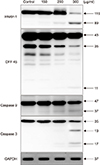1. Chung SH, Jo HI. The analysis of post operative treatment of malignant melanoma using high dose interferon-α2b immunotherapy: preliminary report. J Korean Bone Joint Tumor Soc. 2012; 18:78–82.

2. Lee SJ, Chae YS. New systemic treatment for malignant melanoma. Korean J Med. 2013; 85:357–363.

3. Kim SH, Chung SH. Comparison of high dose interferon-α2b immunotherapy and dacarbazine chemotherapy as postoperative treatment of malignant melanoma. J Korean Orthop Assoc. 2016; 51:426–431.

4. Sohn HO, Park EY, Jung YS, Lee EK, Lee HK, Kim EK. A study on oral health-related quality of life following radiotherapy in patients with head and neck cancer. J Korean Acad Oral Health. 2017; 41:110–115.

5. Fink SL, Cookson BT. Apoptosis, pyroptosis, and necrosis: mechanistic description of dead and dying eukaryotic cells. Infect Immun. 2005; 73:1907–1916.

6. Elmore S. Apoptosis: a review of programmed cell death. Toxicol Pathol. 2007; 35:495–516.

7. Kang SW. Role of reactive oxygen species in cell death pathways. Hanyang Med Rev. 2013; 33:77–82.

8. Soung YH, Lee JW, Kim SY, Nam SW, Park WS, Lee JY, et al. Mutational analysis of proapoptotic bcl-2 family genes in colon carcinomas. Korean J Pathol. 2005; 39:168–171.
9. Brentnall M, Rodriguez-Menocal L, De Guevara RL, Cepero E, Boise LH. Caspase-9, caspase-3 and caspase-7 have distinct roles during intrinsic apoptosis. BMC Cell Biol. 2013; 14:32.

10. Li P, Zhou L, Zhao T, Liu X, Zhang P, Liu Y, et al. Caspase-9: structure, mechanisms and clinical application. Oncotarget. 2017; 8:23996–24008.

11. Bae HK, You SH. Biological activity study on anti-oxidant, whitening, and anti-inflammatory effects of astragalus membranaceus ethanol extracts and bioconversion extracts. Asian J Beauty Cosmetol. 2017; 15:489–499.

12. Cha HY, Ahn SH, Jeong AR, Cheon JH, Park SY, Choi JY, et al. Anti-inflammatory effects of hataedock extracted from coptidis rhizoma and glycyrrhiza uralensis on atopic dermatitis-like skin lesions of NC/Nga mouse. J Int Korean Med. 2015; 36:486–497.
13. Goo YM, Kil YS, Sin SM, Lee DY, Jeong WM, Ko KH, et al. Analysis of antibacterial, anti-inflammatory, and skin-whitening effect of Centella asiatica (L.) Urban. J Plant Biotechnol. 2018; 45:117–124.

14. Jeong SH, Lee JE, Kim BB, Ko Y, Park JB. Evaluation of the effects of Cimicifugae rhizoma on the morphology and viability of mesenchymal stem cells. Exp Ther Med. 2015; 10:629–634.

15. Hostanska K, Nisslein T, Freudenstein J, Reichling J, Saller R. Cimicifuga racemosa extract inhibits proliferation of estrogen receptor-positive and negative human breast carcinoma cell lines by induction of apoptosis. Breast Cancer Res Treat. 2004; 84:151–160.

16. Jeong SH, Guo H, Kim HY, Park JB. Ethanol extract of Cimicifugae rhizoma exerted more potent anti-inflammatory and tumor suppressor activities compared with methanol and water extracts. Biomed Res. 2016; 27:1054–1059.
17. Li JX, Yu ZY. Cimicifugae rhizoma: from origins, bioactive constituents to clinical outcomes. Curr Med Chem. 2006; 13:2927–2951.

18. Kim SJ, Kim MS. Inhibitory effects of Cimicifugae rhizoma extracts on histamine, bradykinin and COX-2 mediated inflammatory actions. Phytother Res. 2000; 14:596–600.

19. Jeong SH, Lee JE, Kim BB, Ko Y, Park JB. Evaluation of the effects of Cimicifugae rhizoma on the morphology and viability of mesenchymal stem cells. Exp Ther Med. 2015; 10:629–634.

20. Lee JE, Kim BB, Ko Y, Jeong SH, Park JB. Effects of Cimicifugae rhizoma on the osteogenic and adipogenic differentiation of stem cells. Exp Ther Med. 2017; 13:443–448.

21. Lee JS, Kim JH, Kim YG. Anticancer effects of caesalpinia sappan extracts on oral carcinoma and osteosarcoma cells. J Korean Assoc Oral Maxillofac Surg. 2007; 33:583–590.
22. Yoo TM, Kim BS, Yoo BC, Yoo HS. Monitoring the change of protein expression in human colon cancer cell SNU-81 treated with the water-extract of coptis japonica. J Korean Pharmacopuncture Inst. 2009; 12:5–12.

23. Fujiki H, Watanabe T, Sueoka E, Rawangkan A, Suganuma M. Cancer prevention with green tea and its principal constituent, EGCG: from early investigations to current focus on human cancer stem cells. Mol Cells. 2018; 41:73–82.
24. Lee JH, Hong SH, Han MH, Jin CY, Choi BT, Choi YH. Apoptosis by Quercetin through induction of Bax and activation of Caspase in human lung carcinoma cells. Cancer Prev Res. 2008; 13:169–176.





 PDF
PDF ePub
ePub Citation
Citation Print
Print






 XML Download
XML Download